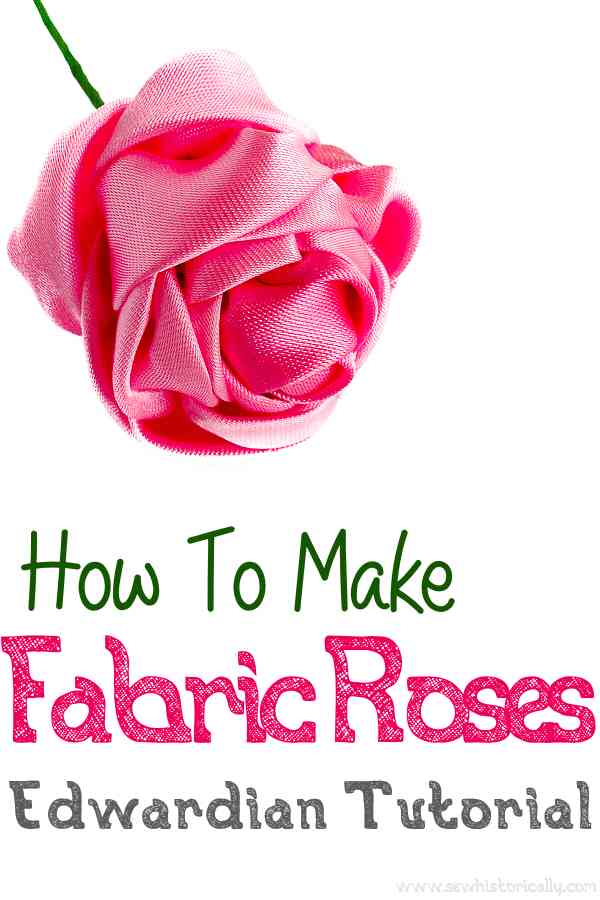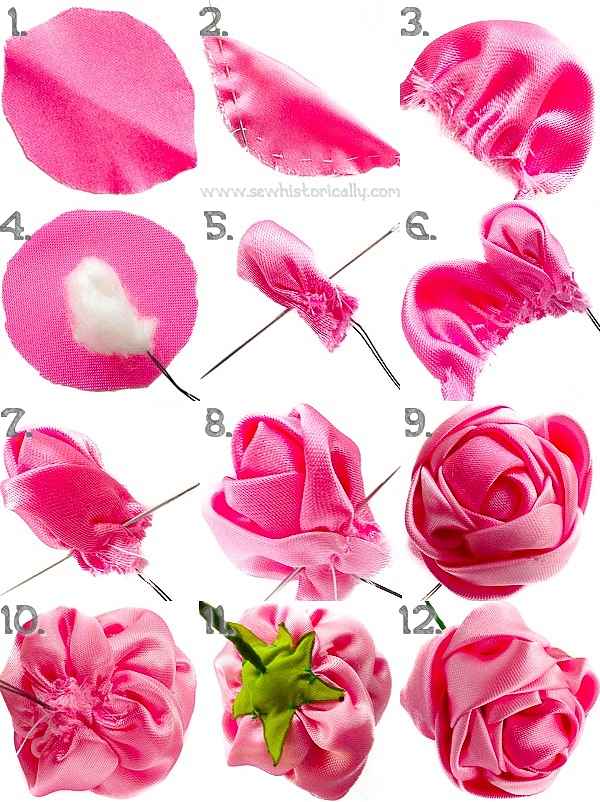‘Roses and buds, lilies, daisies, violets, “forget-me-nots,” dahlias, asters, sweet peas, pansies, carnations, sunflowers, in fact, a great many flowers, are possible of charming reproduction from scraps of silk and ribbon.’ (The Art Of Millinery, 1909)
Materials For DIY Flowers
‘Flowers can be made from almost any fabric – satin, velvet, georgette, maline [similar to bobbinet tulle], ribbon, soft leather, oilcloth, yarn, and chenille. […] Lovely flowers may be made from a few inches of hat braids which are left over from wool and raffia, maline or colored nets.’ (Make Your Own Hats, 1921)
‘Resemblance in form is important rather than likeness in colour. For instance, our rose-buds must be in the shape of rose-buds, but there the likeness may end, for gold tissue may form the petals if we will, or a twist of Wedgwood blue satin may also be allowed to form the rose-bud in this quaint and arbitrary type of flower-making.’ (Every Woman’s Encyclopaedia, 1910-2)
Handmade Flowers With Fabric Scraps
‘A scrapbag for odds and ends should always be kept for small pieces of materials. Any piece two inches square may be used for flowers of fruits. Such a bag of pieces will prove a veritable gold mine to use in making flowers and fruit trimmings.’ (Make Your Own Hats, 1921) ‘Odd scraps of silk can easily be used’ (Every Woman’s Encyclopaedia, 1910-2).
‘Use up scraps of silks, gold and silver tissue, crepe, lace and ribbons of all widths, to make pretty trifles for the hair, etc.’ (The Art Of Millinery, 1909).
Color Shemes
‘A charming colour scheme is in a knot of dark red rosebuds surrounded by tiny little roses in a pale vieux rose shade. […] A particularly smart posy is contrived with three of these [fully-blown roses] in a dark red shade in the centre, about eight in pink and cerise tones around them, with the outer circle of all composed of a single row of rather bright blue forget-me-nots […]
As a rule, it looks smarter not to have an outer rim of leaves, the moss that is attached to these little roses giving all the touch of green that is necessary. With violets, however, leaves are generally an improvement, as the blossoms are apt to look insipid without a touch of green. A dull rose-coloured rose, or one in pink, or dark red, surrounded by violets, looks delightful.’ (Every Woman’s Encyclopaedia, 1910-2)
15 Ways To Use DIY Fabric Flowers
Use DIY Fabric Flowers:
- as hair accessories
- to embellish clothes
- as brooch
- to decorate a hat
- to make a flower crown
- as flower necklace
- to make a flower belt or belt buckle
- in a vase instead of real flowers
- as wall hanging or garland
- to decorate picture frames
- to upcycle a lampshade
- as ornaments for Easter and spring
- to make a DIY spring wreath
- as floral photo backdrop
- for historical costumes
‘Hand-made flowers are always worn more or less on hats, gowns, suits, and muffs. They are especially beautiful on evening gowns.’ (Make Your Own Hats, 1921) ‘Some novelties are in the form of hair slides and pins decorated with little roses made of gold or silver tissue. […] This would also form a very uncommon and dainty buckle for a hat or dress.’ (Every Woman’s Encyclopaedia, 1910-2) Ribbon flowers are ‘used more for hair and corsage ornaments than hat trimming.’ (The Art Of Millinery, 1909)
The floral brooch gives the girl whose purse is not deep enough for a variety of costumes a chance to vary her appearance […] a vivid touch of contrasting colour will make interesting an otherwise commonplace toilette, and render it individual and uncommon. […] A tiny wreath of roses makes a delightful slide for a lace scarf or ribbon necktie […] The necklace of gold cord, artistically decked with roses, is for use with a lace or silk blouse. Its colouring should correspond or be in harmonious contrast with the skirt or with the hat trimming.’ (Every Woman’s Encyclopaedia, 1910-2)
‘Spring millinery generally precedes Nature in its blossoming forth into many coloured flowers. A discreetly arranged little posy of blooms very often form a sufficient trimming for a new toque, or will give that touch of freshness to a last year’s model which will make it pass among the uninitiated as a new purchase. […] A flower buckle is quite expensive to buy, but can be made for a little over a shilling.’ (Every Woman’s Encyclopaedia, 1910-2)
Tips How To Make Fabric Roses
To make DIY flowers, use fabric and ribbon ‘double and if possible on the bias. Lace, however, can be used singly, the shape of the petal outlined in fine lace wire, or silk-covered spool wire, the lace edge turned over this, run in and finished with fine straw braid, chenille, spangles, or narrow lace edging. Petals of net or mousseline de soie from scraps used thus, spangled all over, and edged with tiny lace, make charming flowers, pansies, wild roses, camellias, etc.’ (The Art Of Millinery, 1909).
‘To prepare the petals of any flower is not difficult, but to arrange them is another matter. Study the face of any blossom which you are making and try to make it look as natural as possible. […]
With a little experience one soon becomes efficient and learns how to adjust the different materials. Some materials being more pliable than others, the shape of the petals may be changed slightly to meet the need.’ (Make Your Own Hats, 1921)
‘Silk pieces for flowers should be on the bias, and of thin material, but taffeta, on the straight or bias, can be used for some blossoms, either using the selvedge as one would ribbon, for sweet peas, pansies, orchids, etc., or the edge finely pinked out or frayed, as for carnations, and similar blossoms. For silk roses the material should be on the bias, and of thin make, as it is used double.’ (The Art Of Millinery, 1909)
How To Make Fabric Roses & Silk Roses
The large ‘cabbage-shaped rose […] is composed of piece silk on the cross, with the centre of satin, or a few velvet petals look well. Odd scraps of silk can easily be used, and the petals can be of any length […] The depth of the petals is also not important.’ (Every Woman’s Encyclopaedia, 1910-2)
The American beauty rose ‘may be made of silk or satin; it may have as many petals as desired. Each petal is cut from a piece of folded material […] It is highly important that the folded edge be on a true bias.
Begin the rose by cutting three petals […] with the bias edge one and one-half inches long. Run gathering thread one-eighth of an inch from the curved edge, leaving a thread one inch long so that the petal may be adjusted as it is pinned in place.
Make a loop one inch long on the end of a piece of wire six inches long. Cover this loop with a small circle of the material like the rose. It is sometimes found to be advantageous to fill this circle with cotton to make a soft center for the rose. For an ordinary-sized rose there should be eighteen petals. […]
The next larger in size should have a two-inch bias and be correspondingly wider; the next five should have a two and one-half-inch bias, and the next five a three-inch bias. […]
The three small petals should be arranged around the covered loop of wire and pinned in place before sewing. Sew securely. Each row, as it is arranged according to size, should be pinned in place and scrutinized carefully to see that it is placed effectively. […] See that the face of the flower looks as nearly like a real rose as possible, allowing the back to look as it will. […]
The back of the rose may be finished by adding a sufficient number of green leaves […] The bud used with this rose may be made by using the three smallest petals. […] the stem bound with a narrow gray-green ribbon […] The inside petals may be of a darker shade than the outside.’ (Make Your Own Hats, 1921)
‘If you have no stamens to center the rose with make it of a three-inch square of silk […] which may be the same as the rest, or of a deeper shade, or even a yellow center in a pink rose; indeed several shades of pink may be used in one rose. In arranging the petals lap them slightly, except the outer ones, which may be curved back. […]
If one has neither calyx nor cusps, the first can be replaced by bits of green silk cut out to shape, or narrow ribbon or silk gathered and set on; and a cusp can be made of green sealing wax, molded around a thick wire, first wetted or greased, as it will then pull off. […] Not only odds and ends of silk and ribbons, laces, velvets, etc., but old flowers will often yield the calyx, stamens, cusps, wire, etc., for use in making the flowers.’ (The Art Of Millinery, 1909)
How To Make Scented Silk Flowers
‘Flowers may be suitably perfumed by putting a bit of good sachet powder in the wadding of buds, or between the double ribbon or rose petals, or by laying the materials for a few days in a box with sachet powder.’ (The Art Of Millinery, 1909)
How To Make Rose Leaves
‘The rose foliage may be made if desired. Cut the leaves from green satin or velvet, or color them green with water-color if a light-colored material must be used. After cutting the pieces in the shape of rose leaves (it will require two pieces for each leaf), lay one wrong side up, cover with milliner’s glue [bone glue].
Lay on the center of this a piece of tie wire long enough for the stem. Place another leaf on this and press together. When all the leaves are made after this method, arrange on a long stem or wire, and if wound with brown gum tissue it will look very natural.’ (Make Your Own Hats, 1921)
How To Revive Artificial Flowers
‘If flowers are faded, they made be touched up with water-color. If they are pink, rouge may be used effectively. If the edges are much frayed, trim them slightly with the shears. Green leaves may be dipped in hot paraffine to restore their gloss, or pressed with a warm iron without paraffine. Even very imperfect flowers may be made to look well if veiled with maline or georgette.’ (Make Your Own Hats, 1921)

